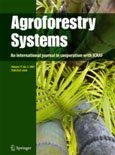We set up four 500–600-m long parallel transects crossing two contrasted edaphic habitats, one lying on clayey soil and the other on sandy soil. The canopy and subcanopy trees were identified and geo-referenced along the transects over a width of 50 m and 5 m, respectively, and soil samples were collected every 50 m to characterize each habitat.
Correspondence analyses indicated a clear differentiation of tree communities between sandy and clayey soils. Using a torus-translation method combined with Chi-squared non-parametric tests, we observed that ca. 40% and 18% of the species represented by at least 12 individuals displayed significant density differences according to habitat in the canopy and subcanopy, respectively, although very few species displayed significant differences in their relative abundance. Nevertheless, whole community tests of differentiation (in species relative abundances) between soil types were significant in both strata, even after removing individual species or families displaying a significant habitat preference.
While only a minority of species displayed a clear habitat preference, we still observed a community-wide impact of the edaphic discontinuity on species assemblages at a local scale. Our results provide further evidence for the major contribution of environmental heterogeneity in maintaining biodiversity in tropical forests.
DOI:
https://doi.org/10.1111/jvs.12209Altmetric score:
Dimensions Citation Count:
Publication year
2014
Authors
Vleminckx, J; Drouet, T.; Amani, C.; Lisingo, J.; Lejoly, J.; Hardy, O.J.
Language
English
Keywords
canopy, species diversity, species richness























